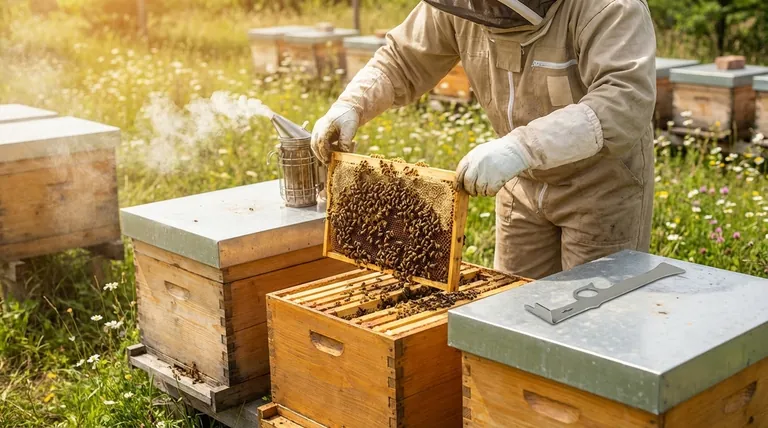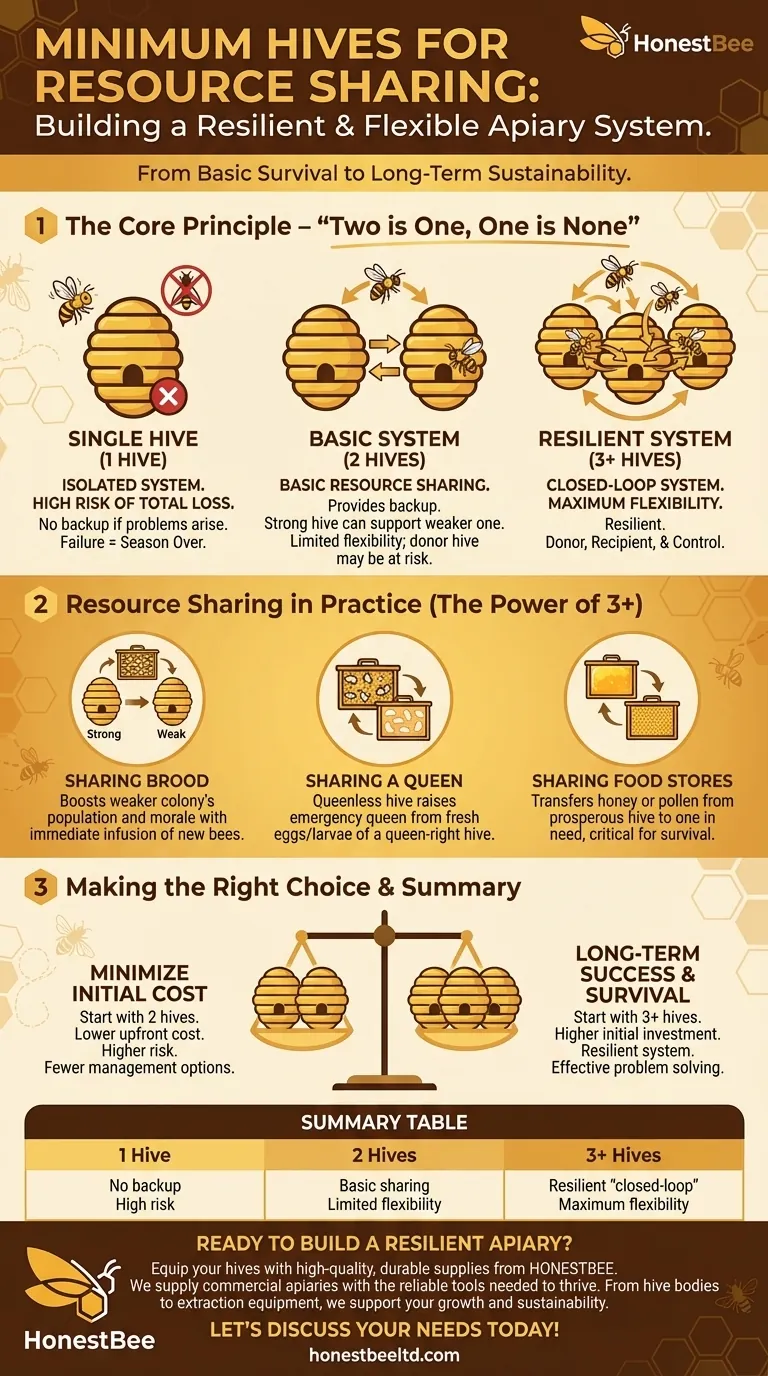To successfully share resources between hives, the absolute minimum number you need is two. However, the most resilient and flexible setup, especially for a new beekeeper, is three hives. This configuration significantly increases your ability to solve common problems and prevent colony loss.
While two hives are technically sufficient, the core principle is not about meeting a minimum number. It's about building a robust system where you have enough resources—bees, brood, and food—to correct imbalances and ensure the survival of all your colonies.

Why "Two is One, and One is None"
The old beekeeping adage, "two is one, and one is none," highlights a critical truth about hive management. A single hive is an isolated system with no backup. If it fails, your beekeeping season is over.
The Problem with a Single Hive
A lone hive leaves you with zero options if problems arise. If the queen fails, the colony becomes overrun with pests, or it struggles to build up strength, you have no internal resources to fix the issue. You become entirely dependent on purchasing a new queen or a package of bees, which may not be available when you need them.
The Power of a Second Hive
With two hives, you can begin to manage your apiary as a system. The stronger hive can be used to support the weaker one. This is the foundational concept of resource sharing.
The Strategic Advantage of Three Hives
While two hives are good, three hives are demonstrably better. This isn't about having more honey; it's about having more management options and a significantly higher chance of success. Three hives create a "closed-loop" system where you can solve most problems without external purchases.
How Resource Sharing Works in Practice
With multiple hives, you can equalize their strength and solve specific issues by transferring key resources.
-
Sharing Brood: You can move a frame of capped brood (larvae sealed in their cells) from a strong hive to a weaker one. This provides an immediate "infusion" of new bees that will hatch and boost the weaker colony's population and morale.
-
Sharing a Queen: If one hive becomes queenless, you can take a frame containing fresh eggs or young larvae from a queen-right hive and place it in the queenless one. The bees will use these eggs to raise their own emergency queen.
-
Sharing Food Stores: If one hive is low on honey or pollen, you can transfer a frame of food from a prosperous hive to the one in need. This is especially critical for helping a colony survive winter.
Understanding the Trade-offs
Opting for more hives requires a greater initial investment of time and money. However, this upfront cost is often an insurance policy against the much larger cost of losing a colony entirely.
The Risk of Only Two Hives
With only two hives, you can still face difficult choices. If one hive is very strong and the other is very weak, donating resources may put your strong hive at risk, especially if conditions are poor. You are forced to choose which colony to prioritize.
The Flexibility of Three or More
With three hives, you have a "donor," a "recipient," and a "control." You can take resources from your strongest colony to help your weakest one, leaving the middle hive untouched. This provides a buffer and dramatically increases your flexibility without jeopardizing the health of your strongest producer.
Making the Right Choice for Your Apiary
Your decision should be based on your ultimate goal, whether it's simple pollination, honey production, or the long-term sustainability of your bee population.
- If your primary focus is minimizing initial cost: Start with two hives, but understand you are accepting a higher risk of colony loss and will have fewer management options.
- If your primary focus is long-term success and colony survival: Start with three hives to create a resilient system that allows you to effectively manage and solve problems as they arise.
Ultimately, managing multiple hives gives you the power to act as a true steward, ensuring the health and strength of your entire apiary.
Summary Table:
| Number of Hives | Key Advantage | Main Limitation |
|---|---|---|
| 1 Hive | Lowest initial cost | No backup; high risk of total loss |
| 2 Hives | Basic resource sharing possible | Limited flexibility; donor hive at risk |
| 3+ Hives | Resilient "closed-loop" system; maximum flexibility | Higher initial investment in time and equipment |
Ready to build a resilient, successful apiary?
Starting with the right number of hives is just the beginning. Equipping them with high-quality, durable supplies from a trusted partner is what ensures long-term success.
HONESTBEE supplies commercial apiaries and beekeeping equipment distributors with the reliable tools they need to thrive. From durable hive bodies and frames to essential protective gear and honey extraction equipment, our wholesale-focused operations are built to support your growth and sustainability.
Let's discuss your specific needs. Contact our expert team today to get durable, commercial-grade beekeeping supplies that protect your investment and help your colonies flourish.
Visual Guide

Related Products
- HONESTBEE Advanced Ergonomic Stainless Steel Hive Tool for Beekeeping
- Professional Dual-End Stainless Steel Hive Tool for Beekeeping
- Professional Drop-Style Hive Handles for Beekeeping
- Professional 3-Bar Frame Grip with Integrated Hive Tool
- Professional Galvanized Hive Strap with Secure Locking Buckle for Beekeeping
People Also Ask
- What tools are used for cleaning frames? A Beekeeper's Simple 4-Tool Guide
- Why do hive tools have a hole? Unlock the Secret to Efficient Beekeeping
- What are some common uses of a hive tool? Essential Multi-Purpose Tool for Every Beekeeper
- What is a hive tool and what are its uses? Master Your Hive Inspections with the Essential Beekeeper's Tool
- Why is it important to compare the progress of different hives? A Beekeeper's Key Diagnostic Tool



















